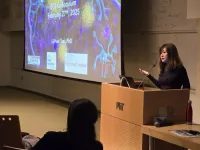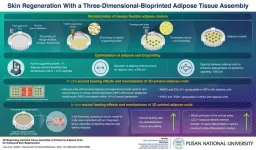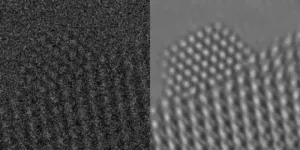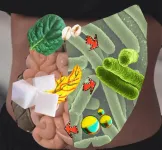(Press-News.org) In brief
- ETH materials researchers have developed a groundbreaking method that enables the near-complete recycling of Plexiglas for the first time.
- The polymer chains are broken down into their individual monomer building blocks, which can then be purified using straightforward distillation processes.
- The mechanism relies on a chlorinated solvent. When exposed to UV light, a chlorine radical is released from the solvent, which then triggers the breakdown of the polymer chain.
Today, plastics recycling is primarily limited to the collection of sorted PET or polyethylene beverage bottles. The plastic collected is of identical chemical composition, with polymer molecules of similar lengths. The additives used to enhance properties such as colour, softness, or sunlight resistance are also similar.
This process enables plastic to be melted down and reformed into new bottles. In contrast, plastics of various types and qualities (known as mixed plastics) are usually incinerated to generate heat in cement plants, for example.
Plexiglas polymers completely broken down into monomers
A team of scientists led by Athina Anastasaki from the Laboratory of Polymeric Materials at ETH Zurich has discovered a method that enables the near-complete breakdown of Plexiglas into its monomer building blocks. By using additives, these building blocks can be easily purified through distillation into virgin-grade starting products for the synthesis of new Plexiglas polymers.
The potential implications are significant: with a global annual production of around 3.9 million tonnes, Plexiglas (chemically known as PMMA or polymethyl methacrylate) is a durable and lightweight acrylic material. It is gaining in popularity in the aerospace and automotive industries, in the manufacture of screens and monitors and in the construction industry.
The process developed by the ETH researchers and presented in the journal Science is highly robust. It is also effective with very long polymer chains made up of 10,000 monomer building blocks. Additionally, the presence of additives such as copolymers, plasticizers, dyes, and most other plastics have minimal impact on chain scission. Even when using multicoloured Plexiglas from the DIY market, the yield remains between 94 and 98 percent.
Surprisingly simple process
“Our process is extremely simple,” stresses Anastasaki: “All we need is a chlorine-based solvent and to heat the dissolved recycling mixture to a temperature of between 90 and 150°C to start the depolymerization reaction with the aid of UV or visible light.”
The ETH professor was amazed at how straightforward the process is. Like many other important plastics, such as polyethylene or polypropylene, Plexiglas polymers consist of a polymer chain of carbon atoms with various side groups branching off, depending on the type of plastic. Until today, these uniform carbon chains have posed an insurmountable chemical challenge for targeted splitting into monomers, as they do not provide specific points of attack for splitting reactions.
Pyrolysis and designer polymers not practical
The only method currently used in industry that completely breaks down homogeneous carbon chains is pyrolysis. This involves the thermal decomposition of carbon chains at around 400°C. However, these reactions are non-specific, resulting in a mixture of various cleavage products. The large amount of energy required for this process, along with the costs associated with purifying the resulting mixture, severely limits the economic efficiency of pyrolysis.
For several years, various research groups have been experimenting with modified polymers. They have introduced easily detachable molecular groups at the ends of the polymer chains, which then trigger deconstruction from the end of the chain. In this way, the researchers have achieved yields of up to over 90 percent.
However, these designer polymers have many major disadvantages. In addition to the need to be first integrated into established plastic production, their reactive end groups significantly limit the thermal stability of the polymers and thus their possible uses. Furthermore, many of the commonly used plastic additives reduce the yield of the reactions, with the result that depolymerization only works to a limited extent, even in the case of the long polymer chains that often occur in commercial plastics.
The solvent determines the reaction
As is so frequently the case in chemistry, the new method was discovered by chance. As Anastasaki explains: “We were actually looking for specific catalysts that would promote the targeted breakdown into monomers. But a control experiment led to the surprising revelation that the catalyst was not even necessary.” The chlorinated solvent in which the crushed Plexiglas sample was dissolved was enough to virtually completely split the polymer with the help of UV light.
When the researchers had a closer look at the splitting reaction, they came across a surprising mechanism. They discovered that the chemically active particle in the reaction was a chlorine radical that is split off from the chlorinated solvent when excited by UV light. What was unexpected was that the high-wavelength light can break the chlorine’s bond with the solvent molecule. This happens as part of a relatively esoteric photochemical phenomenon whereby a very small fraction of the solvent molecules absorbs high-wavelength UV light.
The chlorine must go
In the future, however, the ETH researcher wants to dispense with the chlorinated solvent in her recycling process: “Chlorinated chemical compounds harm the environment. Our next goal is therefore to modify the reactions to enable them to work without the chlorinated solvent.”
It is still unclear how and when the ETH method will be implemented in practice. In any case, Anastasaki and her team of researchers have opened the door to new recycling methods that can be used to bring about the targeted breakdown of previously chemically inaccessible carbon chains of plastics.
END
Complete breakdown of Plexiglas into its building blocks
Recycling breakthrough
2025-03-03
ELSE PRESS RELEASES FROM THIS DATE:
New study suggests a shift in diabetes testing after pregnancy to improve women's health
2025-03-03
Caring for a baby is a full-time job, often causing new mothers to overlook their own health needs. This situation is exemplified by the low compliance with postpartum glucose screening among women who had gestational diabetes—a condition that significantly increases their risk of developing type 2 diabetes later in life.
Now new research published today in Diabetes Care indicates that a shorter, one-hour glucose tolerance test outperforms the standard two-hour test in predicting future risk of diabetes and could transform clinical practice.
The research was led by Dr. Ravi Retnakaran, a Clinician Scientist at the Lunenfeld-Tanenbaum Research Institute, an Endocrinologist ...
FOME alliance pioneers VR innovation in management education
2025-03-03
By pooling the resources and expertise from alliance members, the initiative addresses common challenges in VR adoption for education, such as high development costs and lack of in-house technical expertise. The module provides a device-agnostic, 3D and 2D-accessible VR experience, enabling immersive learning opportunities for students and executives worldwide. As part of the module, a 20-minute pilot scenario allows users to engage in crisis management exercises, honing their soft skills through interactions with a digital counterpart (avatar). By uniting under a shared mission, individual alliance members’ ...
Evidence expanding that 40Hz gamma stimulation promotes brain health
2025-03-03
A decade after scientists in The Picower Institute for Learning and Memory at MIT first began testing whether sensory stimulation of the brain’s 40Hz “gamma” frequency rhythms could treat Alzheimer’s disease in mice, a growing evidence base supporting the idea that it can improve brain health—in humans as well as animals—has emerged from the work of labs all over the world. A new review article in PLOS Biology describes the state of research so far and presents some of the fundamental and clinical questions at the forefront of the non-invasive gamma stimulation now.
“As ...
Teaching kids how to become better citizens
2025-03-03
COLUMBUS, Ohio – In our polarized society, a new study offers hope for the future: Even young children can learn to discuss and argue about meaningful problems in a respectful and productive way.
Researchers at The Ohio State University found success in a social studies curriculum for fourth graders based on teaching what they called “civic competencies.”
Over the course of a school year, findings showed that the students participating in the curriculum significantly improved their argumentation skills and disciplinary thinking.
“This will give them the ability to collaborate, communicate effectively and consider multiple perspectives”, ...
Pusan National University researchers develop a novel 3D adipose tissue bioprinting method
2025-03-03
The adipose tissue, which serves as an endocrine organ, releases various molecules that regulate the repair of other damaged tissues, including the skin. Hence, adipose tissues can potentially be reengineered to regenerate the damaged organs. Three-dimensional (3D) bioprinting technology has revolutionized regenerative medicine by enabling the generation of engineered and functional 3D organs or tissues, including adipose tissues. However, the currently used tissue biofabrication methods cannot replicate ...
Scientists use AI to better understand nanoparticles
2025-03-03
A team of scientists has developed a method to illuminate the dynamic behavior of nanoparticles, which are foundational components in the creation of pharmaceuticals, electronics, and industrial and energy-conversion materials. The advance, reported in the journal Science, combines artificial intelligence with electron microscopy to render visuals of how these tiny bits of matter respond to stimuli.
“Nanoparticle-based catalytic systems have a tremendous impact on society,” explains Carlos Fernandez-Granda, director of NYU’s Center for Data Science and a professor of mathematics and data science, one of the paper’s authors. “It is estimated that 90 percent ...
We feed gut microbes sugar, they make a compound we need
2025-03-03
Gut microbes that were thought to feed exclusively on dietary fiber also get fed sugar from our guts, from which they produce short-chain fatty acids that are crucial to many body functions. The Kobe University discovery of this symbiotic relationship also points the way to developing novel therapeutics.
Gut microbes produce many substances that our body needs but cannot produce itself. Among them are short-chain fatty acids that are the primary energy source for the cells lining our guts but have other important roles, too, and ...
One of the largest psychotherapy trials in the world has implications for transforming mental health care during pregnancy and after birth
2025-03-03
Approximately one in five of pregnant and postpartum individuals experience depression and anxiety, yet less than 10 per cent receive proper treatment.
To address this problem, a team of interdisciplinary researchers from Canada and the United States investigated if talk therapy can be effectively delivered by non-mental health specialists and telemedicine to increase access. In a paper published today in Nature Medicine, they share results from the Scaling Up Maternal Mental health care by Increasing access to Treatment (SUMMIT) Trial, which reveals promising strategies to provide the necessary support and treatment more effectively and inclusively ...
It’s not just what you say – it’s also how you say it
2025-03-03
EVANSTON, Ill. --- You’ve probably heard the phrase, “It’s not what you say, it’s how you say it,” and now, science backs it up. A first-of-its-kind study from Northwestern University’s School of Communication, the University of Pittsburgh and the University of Wisconsin-Madison reveals a region of the brain, long known for early auditory processing, plays a far greater role in interpreting speech than previously understood.
The multidisciplinary study being published Monday, March ...
Sleep patterns may reveal comatose patients with hidden consciousness
2025-03-03
NEW YORK, NY (March 3, 2025)--Several studies in the past decade have revealed that up to a quarter of unresponsive patients with recent brain injuries may possess a degree of consciousness that’s normally hidden from their families and physicians.
New research from Columbia University and NewYork-Presbyterian may soon help physicians identify unresponsive brain-injury patients with hidden consciousness who are likely to achieve long-term recovery by looking for brain waves that are indicative of normal sleep patterns.
“We’re at an exciting crossroad in neurocritical care where we know that many patients appear to be unconscious, but some are recovering without ...
LAST 30 PRESS RELEASES:
Scalable and healable gradient textiles for multi‑scenario radiative cooling via bicomponent blow spinning
Research shows informed traders never let a good climate crisis go to waste
Intelligent XGBoost framework enhances asphalt pavement skid resistance assessment
Dual-function biomaterials for postoperative osteosarcoma: Tumor suppression and bone regeneration
New framework reveals where transport emissions concentrate in Singapore
NTP-enhanced lattice oxygen activation in Ce-Co catalysts for low-temperature soot combustion
Synergistic interface engineering in Cu-Zn-Ce catalysts for efficient CO2 hydrogenation to methanol
COVID-19 leaves a lasting mark on the human brain
Scientists use ultrasound to soften and treat cancer tumors without damaging healthy tissue
Community swimming program for Black youth boosts skills, sense of belonging, study finds
Specific depressive symptoms in midlife linked to increased dementia risk
An ‘illuminating’ design sheds light on cholesterol
Who is more likely to get long COVID?
Study showcases resilience and rapid growth of “living rocks”
Naval Research Lab diver earns Office of Naval Research 2025 Sailor of the Year
New Mayo-led study establishes practical definition for rapidly progressive dementia
Fossil fuel industry’s “climate false solutions” reinforce its power and aggravate environmental injustice
Researchers reveal bias in a widely used measure of algorithm performance
Alcohol causes cancer. A study from IOCB Prague confirms damage to DNA and shows how cells defend against it
Hidden viruses in wastewater treatment may shape public health risks, study finds
Unlock the power of nature: how biomass can transform climate mitigation
Biochar reshapes hidden soil microbes that capture carbon dioxide in farmland
Reducing saturated fat intake shows mortality benefit, but only in high-risk individuals
Manta rays create mobile ecosystems, study finds
Study: Mixed results in using lipoic acid to treat progressive multiple sclerosis
Norbert Holtkamp appointed director of Fermi National Accelerator Laboratory
New agentic AI platform accelerates advanced optics design
Biologists discover neurons use physical signals — not electricity — to stabilize communication
Researchers discover that a hormone can access the brain by hitchhiking
University of Oklahoma researcher awarded funding to pursue AI-powered material design
[Press-News.org] Complete breakdown of Plexiglas into its building blocksRecycling breakthrough



